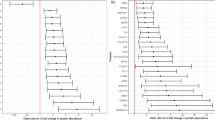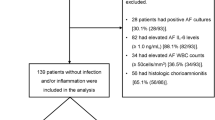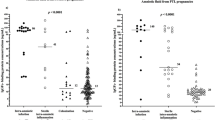Abstract
Objective:
To evaluate the association between the concentrations of immune-related proteins in mid-trimester amniotic fluid (AF) and the subsequent risk of spontaneous preterm delivery in twins.
Study Design:
The study population consisted of consecutive women with a twin pregnancy who underwent clinically indicated genetic amniocentesis at 15 to 20 weeks, and had a subsequent spontaneous delivery in the early preterm period (<32 weeks (cases)) or at term (37 to 42 weeks (controls)). AF was analyzed for cytokines (interleukin (IL)-1ß, IL-2, IL-4, IL-5, IL-6, IL-8, IL-10, IL-12, IL-13 and IL-15, interferon-γ, tumor necrosis factor-α), matrix metalloproteinases (MMP-1, MMP-2, MMP-3, MMP-8, MMP-9 and MMP-12), and chemokines (complement factor-D/Adipsin, Serpin E1/PAI-1, Adiponectin/Acrp30, C-Reactive Protein, CCL2/MCP-1, Leptin, Resistin) using multiplex immunoassay kits. The association between AF protein levels and subsequent early preterm birth were examined.
Result:
A total of 96 sets of twins were enrolled, including 17 early preterm birth cases and 79 term controls. AF concentrations of IL-6, IL-8, MMP-3, MMP-8 and MMP-9, and CCL2/MCP-1 were significantly higher in cases than controls. Among these analytes, the combination of AF IL-8 and MMP-9 values had the highest predictive value for early preterm birth. The risk was 8% (10/132) for IL-8<1200 pg ml−1 and MMP-9<1000 pg ml−1, 30% (15/50) for IL-8>1200 pg ml−1 or MMP-9>1000 pg ml−1, and 90% (9/10) for IL-8>1200 pg ml−1 and MMP-9>1000 pg ml−1 (P<0.001).
Conclusion:
High concentrations of IL-8 and MMP-9 in mid-trimester AF in twins predicted well the risk of early preterm birth.
This is a preview of subscription content, access via your institution
Access options
Subscribe to this journal
Receive 12 print issues and online access
$259.00 per year
only $21.58 per issue
Buy this article
- Purchase on Springer Link
- Instant access to full article PDF
Prices may be subject to local taxes which are calculated during checkout


Similar content being viewed by others
References
Martin JA, Hamilton BE, Sutton PD, Ventura SJ, Menacker F, Kirmeyer S et al. Births: final data for 2005. Natl Vital Stat Rep 2007; 56: 1–103.
Mathews TJ, MacDorman MF . Infant mortality statistics from the 2005 period linked birth/infant death data set. Natl Vital Stat Rep 2008; 57: 1–32.
Yoon BH, Romero R, Park JS, Kim CJ, Kim SH, Choi JH et al. Fetal exposure to an intra-amniotic inflammation and the development of cerebral palsy at the age of three years. Am J Obstet Gynecol 2000; 182: 675–681.
Rovira N, Alarcon A, Iriondo M, Ibanez M, Poo P, Cusi V et al. Impact of histological chorioamnionitis, funisitis and clinical chorioamnionitis on neurodevelopmental outcome of preterm infants. Early Hum Dev 2011; 87: 253–257.
Zanardo V, Vedovato S, Suppiej A, Trevisanuto D, Migliore M, Di Venosa B et al. Histological inflammatory responses in the placenta and early neonatal brain injury. Pediatr Dev Pathol 2008; 11: 350–354.
Polam S, Koons A, Anwar M, Shen-Schwarz S, Hegyi T . Effect of chorioamnionitis on neurodevelopmental outcome in preterm infants. Arch Pediatr Adolesc Med 2005; 159: 1032–1035.
Shim SS, Romero R, Hong JS, Park CW, Jun JK, Kim BI et al. Clinical significance of intra-amniotic inflammation in patients with preterm premature rupture of membranes. Am J Obstet Gynecol 2004; 191: 1339–1345.
Spinillo A, Capuzzo E, Stronati M, Ometto A, Orcesi S, Fazzi E . Effect of preterm premature rupture of membranes on neurodevelopmental outcome: follow up at two years of age. Br J Obstet Gynaecol 1995; 102: 882–887.
Yoon BH, Oh SY, Romero R, Shim SS, Han SY, Park JS et al. An elevated amniotic fluid matrix metalloproteinase-8 level at the time of mid-trimester genetic amniocentesis is a risk factor for spontaneous preterm delivery. Am J Obstet Gynecol 2001; 185: 1162–1167.
La Sala GB, Ardizzoni A, Capodanno F, Manca L, Baschieri MC, Soncini E et al. Protein microarrays on midtrimester amniotic fluids: a novel approach for the diagnosis of early intrauterine inflammation related to preterm delivery. Int J Immunopathol Pharmacol 2012; 25: 1029–1040.
Puchner K, Iavazzo C, Gourgiotis D, Boutsikou M, Baka S, Hassiakos D et al. Mid-trimester amniotic fluid interleukins (IL-1beta, IL-10 and IL-18) as possible predictors of preterm delivery. In Vivo 2011; 25: 141–148.
Pressman EK, Thornburg LL, Glantz JC, Earhart A, Wall PD, Ashraf M et al. Inflammatory cytokines and antioxidants in midtrimester amniotic fluid: correlation with pregnancy outcome. Am J Obstet Gynecol 2011; 204 (155): e151–e157.
Bamberg C, Fotopoulou C, Thiem D, Roehr CC, Dudenhausen JW, Kalache KD . Correlation of midtrimester amniotic fluid cytokine concentrations with adverse pregnancy outcome in terms of spontaneous abortion, preterm birth, and preeclampsia. J Matern Fetal Neonatal Med 2012; 25: 812–817.
Malamitsi-Puchner A, Vrachnis N, Samoli E, Baka S, Alexandrakis G, Puchner KP et al. Investigation of midtrimester amniotic fluid factors as potential predictors of term and preterm deliveries. Mediators Inflamm 2006; 2006: 94381.
Romero R, Yoon BH, Mazor M, Gomez R, Gonzalez R, Diamond MP et al. A comparative study of the diagnostic performance of amniotic fluid glucose, white blood cell count, interleukin-6, and gram stain in the detection of microbial invasion in patients with preterm premature rupture of membranes. Am J Obstet Gynecol 1993; 169: 839–851.
Borna S, Mirzaie F, Abdollahi A . Mid-trimester amniotic fluid C-reactive protein, ferritin and lactate dehydrogenase concentrations and subsequent risk of spontaneous preterm labour. Aust NZ J Obstet Gynaecol 2009; 49: 400–403.
Keeler SM, Kiefer DG, Rust OA, Vintzileos A, Atlas RO, Bornstein E et al. Comprehensive amniotic fluid cytokine profile evaluation in women with a short cervix: which cytokine(s) correlates best with outcome? Am J Obstet Gynecol 2009; 201 (276): e271–e276.
Mazaki-Tovi S, Romero R, Vaisbuch E, Kusanovic JP, Erez O, Mittal P et al. Adiponectin in amniotic fluid in normal pregnancy, spontaneous labor at term, and preterm labor: a novel association with intra-amniotic infection/inflammation. J Matern Fetal Neonatal Med 2010; 23: 120–130.
Hauguel-de Mouzon S, Guerre-Millo M . The placenta cytokine network and inflammatory signals. Placenta 2006; 27: 794–798.
Zeger SL, Liang KY . Longitudinal data analysis for discrete and continuous outcomes. Biometrics 1986; 42: 121–130.
Perni SC, Vardhana S, Korneeva I, Tuttle SL, Paraskevas LR, Chasen ST et al. Mycoplasma hominis and Ureaplasma urealyticum in midtrimester amniotic fluid: association with amniotic fluid cytokine levels and pregnancy outcome. Am J Obstet Gynecol 2004; 191: 1382–1386.
Nguyen DP, Gerber S, Hohlfeld P, Sandrine G, Witkin SS . Mycoplasma hominis in mid-trimester amniotic fluid: relation to pregnancy outcome. J Perinat Med 2004; 32: 323–326.
Gerber S, Vial Y, Hohlfeld P, Witkin SS . Detection of Ureaplasma urealyticum in second-trimester amniotic fluid by polymerase chain reaction correlates with subsequent preterm labor and delivery. J Infect Dis 2003; 187: 518–521.
Khairy P, Ouyang DW, Fernandes SM, Lee-Parritz A, Economy KE, Landzberg MJ . Pregnancy outcomes in women with congenital heart disease. Circulation 2006; 113: 517–524.
van Nimwegen FA, Penders J, Stobberingh EE, Postma DS, Koppelman GH, Kerkhof M et al. Mode and place of delivery, gastrointestinal microbiota, and their influence on asthma and atopy. J Allergy Clin Immunol 2011; 128 (948-955): e941–e943.
Xu WL, Atti AR, Gatz M, Pedersen NL, Johansson B, Fratiglioni L . Midlife overweight and obesity increase late-life dementia risk: a population-based twin study. Neurology 2011; 76: 1568–1574.
Huang T, Hoffman B, Meschino W, Kingdom J, Okun N . Prediction of adverse pregnancy outcomes by combinations of first and second trimester biochemistry markers used in the routine prenatal screening of Down syndrome. Prenat Diagn 2010; 30: 471–477.
Afzali N, Mohajeri M, Malek A, Alamatian A . Cervical gland area: a new sonographic marker in predicting preterm delivery. Arch Gynecol Obstet 2012; 285: 255–258.
Crane JM, Hutchens D . Transvaginal sonographic measurement of cervical length to predict preterm birth in asymptomatic women at increased risk: a systematic review. Ultrasound Obstet Gynecol 2008; 31: 579–587.
Acknowledgements
This study was supported by a grant of the Korea Health R&D Project through the Korea Health Industry Development Institute (KHIDI), funded by the Ministry of Health & Welfare, Republic of Korea (HI12C00240300) and by a grant of the Seoul National University Hospital Research Fund (03-2012-0160).
Author information
Authors and Affiliations
Corresponding author
Ethics declarations
Competing interests
The authors declare no conflict of interest.
Additional information
DISCLAIMER
This study was presented at the 34th Annual Meeting of the Society for Maternal–Fetal Medicine, New Orleans, LA, USA, 3–8 February 2014.
Supplementary Information accompanies the paper on the Journal of Perinatology website
Supplementary information
Rights and permissions
About this article
Cite this article
Lee, S., Park, J., Norwitz, E. et al. Mid-trimester amniotic fluid pro-inflammatory biomarkers predict the risk of spontaneous preterm delivery in twins: a retrospective cohort study. J Perinatol 35, 542–546 (2015). https://doi.org/10.1038/jp.2015.29
Received:
Revised:
Accepted:
Published:
Issue Date:
DOI: https://doi.org/10.1038/jp.2015.29
This article is cited by
-
The amniotic fluid proteome predicts imminent preterm delivery in asymptomatic women with a short cervix
Scientific Reports (2022)
-
Vaginom- und „Endometriom“-Diagnostik bei Kinderwunsch
Gynäkologische Endokrinologie (2022)
-
Pregnancy outcome in more than 5000 births to women with viral hepatitis: a population-based cohort study in Sweden
European Journal of Epidemiology (2017)



